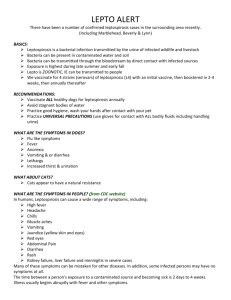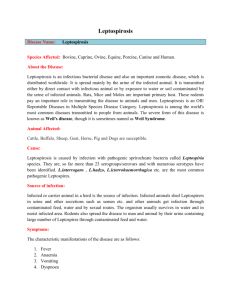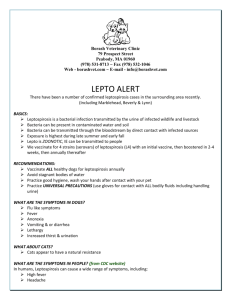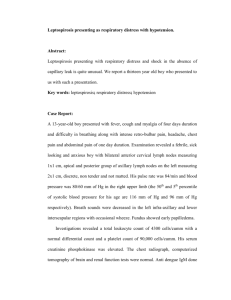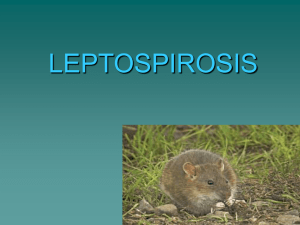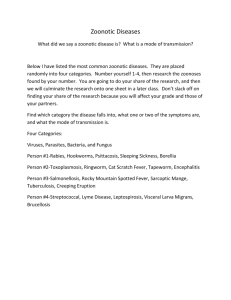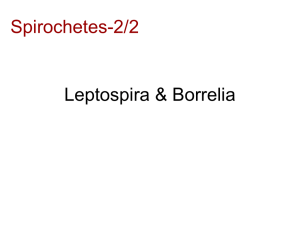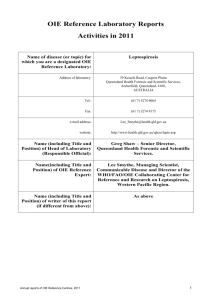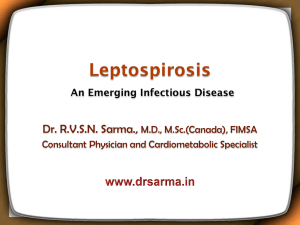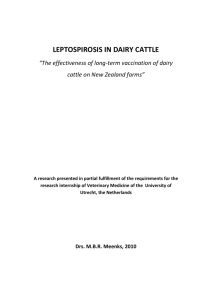NATIONAL INSTITUTE FOR COMMUNICABLE DISEASES
advertisement
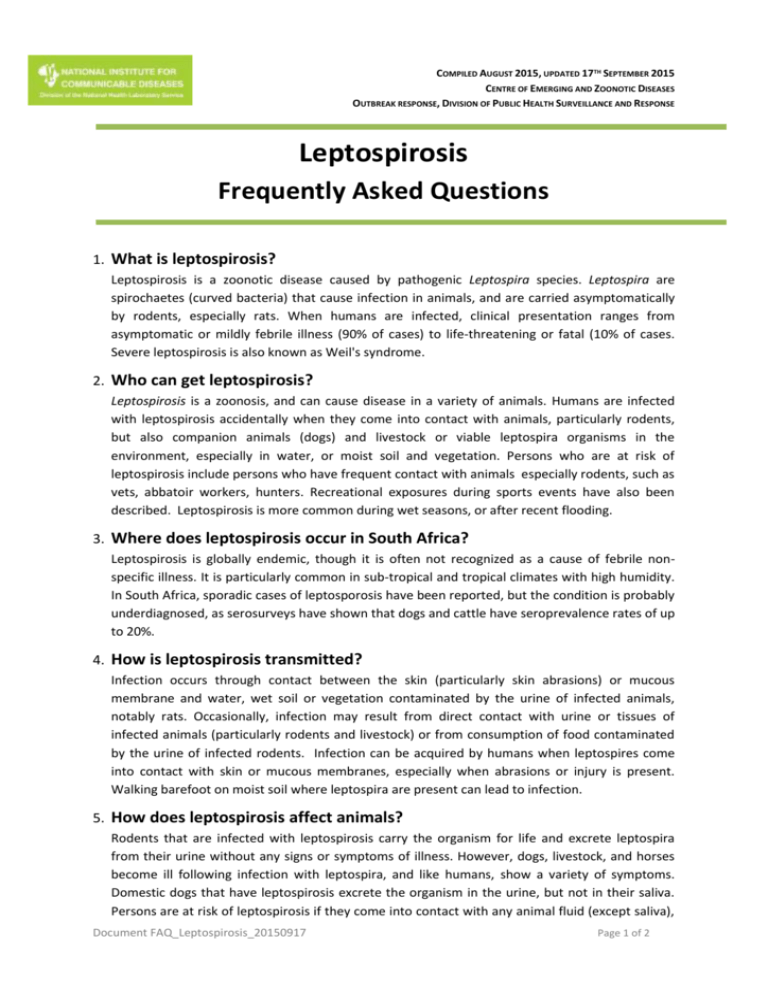
COMPILED AUGUST 2015, UPDATED 17TH SEPTEMBER 2015 CENTRE OF EMERGING AND ZOONOTIC DISEASES OUTBREAK RESPONSE, DIVISION OF PUBLIC HEALTH SURVEILLANCE AND RESPONSE Leptospirosis Frequently Asked Questions 1. What is leptospirosis? Leptospirosis is a zoonotic disease caused by pathogenic Leptospira species. Leptospira are spirochaetes (curved bacteria) that cause infection in animals, and are carried asymptomatically by rodents, especially rats. When humans are infected, clinical presentation ranges from asymptomatic or mildly febrile illness (90% of cases) to life-threatening or fatal (10% of cases. Severe leptospirosis is also known as Weil's syndrome. 2. Who can get leptospirosis? Leptospirosis is a zoonosis, and can cause disease in a variety of animals. Humans are infected with leptospirosis accidentally when they come into contact with animals, particularly rodents, but also companion animals (dogs) and livestock or viable leptospira organisms in the environment, especially in water, or moist soil and vegetation. Persons who are at risk of leptospirosis include persons who have frequent contact with animals especially rodents, such as vets, abbatoir workers, hunters. Recreational exposures during sports events have also been described. Leptospirosis is more common during wet seasons, or after recent flooding. 3. Where does leptospirosis occur in South Africa? Leptospirosis is globally endemic, though it is often not recognized as a cause of febrile nonspecific illness. It is particularly common in sub-tropical and tropical climates with high humidity. In South Africa, sporadic cases of leptosporosis have been reported, but the condition is probably underdiagnosed, as serosurveys have shown that dogs and cattle have seroprevalence rates of up to 20%. 4. How is leptospirosis transmitted? Infection occurs through contact between the skin (particularly skin abrasions) or mucous membrane and water, wet soil or vegetation contaminated by the urine of infected animals, notably rats. Occasionally, infection may result from direct contact with urine or tissues of infected animals (particularly rodents and livestock) or from consumption of food contaminated by the urine of infected rodents. Infection can be acquired by humans when leptospires come into contact with skin or mucous membranes, especially when abrasions or injury is present. Walking barefoot on moist soil where leptospira are present can lead to infection. 5. How does leptospirosis affect animals? Rodents that are infected with leptospirosis carry the organism for life and excrete leptospira from their urine without any signs or symptoms of illness. However, dogs, livestock, and horses become ill following infection with leptospira, and like humans, show a variety of symptoms. Domestic dogs that have leptospirosis excrete the organism in the urine, but not in their saliva. Persons are at risk of leptospirosis if they come into contact with any animal fluid (except saliva), Document FAQ_Leptospirosis_20150917 Page 1 of 2 or animal tissue and blood if the animal has leptospirosis. A vaccine is available to protect cattle, dogs and horses from certain strains of leptospirosis. 6. What are the signs and symptoms of leptospirosis? Leptospiral infections take many different clinical forms, usually with sudden onset of fever, severe headache, myalgia, chills, vomiting, diarrhoea, abdominal pain, conjunctival suffusion and skin rash. The disease may progress to meningitis, haemolytic anaemia, jaundice, haemorrhagic fever and other complications, including hepatorenal failure (Weil’s disease). Initial presentation may resemble pneumonia. Leptospirosis may present as an aseptic meningitis/encephalitis, or as influenza. The symptoms in humans appear after a 2 – 20 (mode=10) day incubation period. Leptospirosis is a biphasic disease, with the first phase presenting as a flu-like illness, followed by brief respite and then meningitis, liver damage (causing jaundice), and renal failure. 7. How is leptospirosis diagnosed? Specimen collection and transport: Paired serum samples are required for serological testing, or blood for detection of Leptospira spp DNA by PCR. Specimens are to be collected from the patient and refrigerated, and sent to the laboratory as soon as possible. Diagnostic tests: A validated commercially available antibody test (IgM ELISA test) is offered by the Special Bacterial Pathogens Reference Laboratory (Centre for Emerging and Zoonotic Diseases) at the NICD. The test is positive from 4-7 days after onset of illness and remains positive for 3-12 months after illness. Paired sera taken 1-2 weeks apart showing a conversion from negative to positive, or an increase in titre, are confirmatory. PCR on blood is usually only positive within the first 7-10 days of illness, after which the organism cannot be found in the blood. A positive PCR reaction for Leptospira spp DNA is confirmatory for the diagnosis. Culture of Leptospira spp from clinical specimens, and the reference test for leptospirosis, the microagglutination test (MAT), are not available for human testing in South Africa as both are laborious and require specialised media and technical expertise. 8. How is leptospirosis treated? Leptosporosis can be treated with doxycline, ceftriaxone, ampicillin or penicillin. Severe disease should be treated with intravenous penicillin. Patients treated with penicillin should be monitored for reactions. Supportive treatment in severe cases will be necessary to maintain renal function. 9. How can leptospirosis be prevented? Leptospirosis can be prevented as follows: Avoid all direct or indirect contact with rodents. Ensure that the environment does not support rodent infestation – place refuse in rodent proof containers, clean up food or food waste, close sewers and cover or drain open water sources, and trap and remove rodents regularly. In urban informal settlements, ensure regular removal of waste and trapping of rodents. Ensure provision is made for safe and hygienic disposal of human waste. Use protective clothes such as gloves and masks in occupations that expose one to the risk of being infected, such as working with animals, or cleaning up waste in areas where rodents live. Avoid swimming or wading in potentially contaminated waters including canals, ponds, rivers, streams and swamps. Wear shoes when outdoors, or in areas that are potentially rodent infested. Document FAQ_Leptospirosis_20150917 Page 2 of 2
